Compressive Behavior of Waste-Steel-Fiber-Reinforced Concrete-Filled Steel Tubes with External Steel Rib Rings
Abstract
1. Introduction
2. Experimental Process and Method
2.1. Material Properties
2.1.1. Steel Tubes and Steel Bars
2.1.2. Waste Steel Fibers
2.1.3. Concrete
2.2. Specimens’ Manufacture and Curing
2.3. Testing Process
2.3.1. Loading Equipment and Measuring Point Arrangement
2.3.2. Loading System
3. Results and Discussion
3.1. Deformation Process and Failure Mode
3.1.1. Specimens Without Rib Rings
3.1.2. Specimens with Only One Rib Ring at the End
3.1.3. Specimens with Only One Rib Ring at the Top and End
3.1.4. Specimens with Multiple Rib Rings
3.1.5. Discussion of the Failure Modes
3.2. Load–Displacement Curve
3.3. Load–Strain Curves
3.4. Splitting Tensile Strength
4. Analysis of Factors Affecting Bearing Capacity
4.1. Rib Ring Number (N)
4.2. Rib Ring Spacing (S)
4.3. Rib Ring Position (S)
4.4. Waste Steel Fiber Content (S)
4.5. Ductility of Specimens
4.6. Calculation Formula of Axial Bearing Capacity
5. Conclusions
- (1)
- Setting rib ring constraints outside the steel pipe significantly improves the mechanical performance of the column. Compared with traditional steel–concrete columns, the axial bearing capacity was increased by 32.5–53.17%. The performance of the column was optimal when the rib ring spacing was between H/8 and H/4 (50–100 mm), and the stress distribution of the steel tube was most uniform when the number of rib rings was greater than the column height-to-diameter ratio.
- (2)
- The addition of WSF to concrete effectively improves the performance of the columns after peak load. The ductility of all specimens increased by at least 10%, and the bearing capacity increased by 2.86–10.49%, showing excellent improvements in crack resistance and energy dissipation.
- (3)
- If the recommended number of rib configurations in this type of structural design is 4–6 and the rib ring spacing is greater than 100 mm, the diameter range of rib ring steel bars is 6–10 mm, and the optimal volume fraction of WSF is 1.0–1.5%.
- (4)
- Based on the Von Mises yield criterion, considering the interaction of the rib rings, steel tube, and concrete under three-dimensional stress states, a theoretical formula for calculating the axial compressive bearing capacity of external steel rib ring restraint waste-steel-fiber-reinforced concrete-filled steel tube was established according to the double-shear unified theory. The results were compared with the experimental results, and the two were in good agreement.
Author Contributions
Funding
Data Availability Statement
Acknowledgments
Conflicts of Interest
References
- Kumar, S.; Gupta, P.K.; Iqbal, M.A. Experimental and numerical study on self-compacting alkali-activated slag concrete-filled steel tubes. J. Constr. Steel Res. 2024, 214, 108453. [Google Scholar] [CrossRef]
- Sepahvand, M.F.; Lenwari, A.; Young, B. Plastic seismic design of moment-resisting frames using concrete-filled steel tube columns. Eng. Struct. 2025, 322, 119225. [Google Scholar] [CrossRef]
- Van Cao, V. Behaviour of rectangular concrete-filled steel tube beams under monotonic and cyclic loadings. J. Constr. Steel Res. 2024, 220, 108816. [Google Scholar]
- Megahed, K.; Mahmoud, N.S.; Abd-Rabou, S.E.M. Finite Element Modeling for Concrete-Filled Steel Tube Stub Columns Under Axial Compression. Int. J. Steel Struct. 2024, 24, 1229–1250. [Google Scholar] [CrossRef]
- Sornam, I.A.; Dominic, J.R.J. Performance of lightweight coconut shell concrete-filled circular steel tube columns under axial compression. Mater. Res. Express 2024, 11, 085514. [Google Scholar] [CrossRef]
- Ahmad, S.; Kumar, A.; Kumar, K. Axial performance of GGBFS concrete filled steel tubes. Structures 2020, 23, 539–550. [Google Scholar] [CrossRef]
- Elghazouli, A.Y.; Mujdeci, A.; Bompa, D.V.; Guo, Y.T. Experimental cyclic response of rubberised concrete-filled steel tubes. J. Constr. Steel Res. 2022, 199, 107622. [Google Scholar] [CrossRef]
- Ghannam, M.; Song, T.Y. Fire Resistance Design of Concrete-Filled Steel Tube Stub Columns. Fire Technol. 2020, 57, 911–942. [Google Scholar] [CrossRef]
- Kenarangi, H.; Bruneau, M. Shear Strength of Composite Circular Reinforced Concrete-Filled Steel Tubes. J. Struct. Eng. 2020, 146, 04019180. [Google Scholar] [CrossRef]
- Ali, A.A.; Abbas, N.J. Behavior of Box Concrete-Filled Steel Tube Columns Considering Confinement Effect. Int. J. Steel Struct. 2021, 21, 950–968. [Google Scholar] [CrossRef]
- Kenarangi, H.; Bruneau, M.; Varma, A.H.; Ahmad, M. Simplified Equations for Shear Strength of Composite Concrete-Filled Steel Tubes. Eng. J.-Am. Inst. Steel Constr. 2021, 58, 197–221. [Google Scholar] [CrossRef]
- Mansouri, A. Shear Strength of Concrete-Filled Steel Tubes Based on Experimental Results. J. Struct. Eng. 2020, 146, 04020097. [Google Scholar] [CrossRef]
- Van Cao, V.; Trinh, T.M.N. Performance of circular concrete filled steel tubes after fire exposure: Experiments. Structures 2023, 55, 539–550. [Google Scholar]
- Nguyen, D.B.; Lin, W.S.; Liao, W.C. Long-Term Creep and Shrinkage Behavior of Concrete-Filled Steel Tube. Materials 2021, 14, 295. [Google Scholar] [CrossRef]
- Younas, S.; Hamed, E.; Li, D.X.; Uy, B. Eccentrically loaded concrete-filled steel tubes made with high strength materials. Eng. Struct. 2023, 275, 115246. [Google Scholar] [CrossRef]
- Gunawardena, Y.; Aslani, F. Static flexural behaviour of concrete-filled spiral-welded stainless-steel tubes. Thin-Walled Struct. 2020, 151, 106731. [Google Scholar] [CrossRef]
- Alatshan, F.; Osman, S.A.; Hamid, R.; Mashiri, F. Stiffened concrete-filled steel tubes: A systematic review. Thin-Walled Struct. 2020, 148, 106590. [Google Scholar] [CrossRef]
- Schurgacz, P.; Knobloch, M. Concrete-filled hollow section composite columns for multi-storey buildings—Innovation and design. Stahlbau 2023, 92, 155–172. [Google Scholar] [CrossRef]
- Xiamuxi, A.; Chen, H.L.; Liu, C.J. Flexural behavior of reinforced and recycled aggregate concrete-filled square steel tubes. J. Constr. Steel Res. 2024, 221, 108891. [Google Scholar] [CrossRef]
- Le, K.B.; Cao, V.V. Numerical Study of Circular Concrete Filled Steel Tubes Subjected to Pure Torsion. Buildings 2021, 11, 397. [Google Scholar] [CrossRef]
- Ayough, P.; Sulong, N.H.R.; Ibrahim, Z. Analysis and review of concrete-filled double skin steel tubes under compression. Thin-Walled Struct. 2020, 148, 106495. [Google Scholar] [CrossRef]
- Chaves, M.D.F.; Xavier, E.M.; Sarmanho, A.M.C.; Neto, J.G.R. Study of bolts used as shear connectors in concrete-filled steel tubes. Eng. Struct. 2021, 231, 111697. [Google Scholar] [CrossRef]
- Azad, S.K.; Uy, B. A numerical study on shear response of concrete-filled stainless steel tubes. Steel Compos. Struct. 2023, 48, 507–530. [Google Scholar]
- El Ouni, M.H.; Raza, A. Data-driven analysis of concrete-filled steel-tube CFRP-confined NSC columns. Mech. Adv. Mater. Struct. 2022, 29, 5667–5688. [Google Scholar] [CrossRef]
- Allouzi, R.A.; Almasaeid, H.H.; Salman, D.G.; Abendeh, R.M.; Rabayah, H.S. Prediction of Bond-Slip Behavior of Circular/Squared Concrete-Filled Steel Tubes. Buildings 2022, 12, 456. [Google Scholar] [CrossRef]
- Callejas, A.; Palma, R.; Hernández-Figueirido, D.; Rus, G. Damage Detection Using Ultrasonic Techniques in Concrete-Filled Steel Tubes (CFSTs) Columns. Sensors 2022, 22, 4400. [Google Scholar] [CrossRef] [PubMed]
- Younas, S.; Li, D.X.; Hamed, E.; Uy, B. Behaviour of high strength concrete-filled short steel tubes under sustained loading. Steel Compos. Struct. 2021, 39, 159–170. [Google Scholar]
- Abdalla, K.M.; Al-Rousan, R.; Alhassan, M.A.; Lagaros, N.D. Finite-element modelling of concrete-filled steel tube columns wrapped with CFRP. Proc. Inst. Civ. Eng.-Struct. Build. 2020, 173, 844–857. [Google Scholar] [CrossRef]
- Ghannam, M.; Hassan, M.K. Analysis of axial and rotational restrained concrete-filled steel tube columns at elevated temperature br. Eng. Struct. 2023, 278, 115568. [Google Scholar] [CrossRef]
- Kenarangi, H.; Bruneau, M. Investigation of Cyclic-Shear Behavior of Circular-Reinforced Concrete-Filled Steel Tubes. J. Struct. Eng. 2020, 146, 04020057. [Google Scholar] [CrossRef]
- Zhang, T.H.; Wang, Y.H.; Zhai, X.M.; Zhi, X.D.; Zhou, H.Y.; Yu, X. Impact response of stainless steel tube locally-strengthened by concrete-filled steel tube. Int. J. Impact Eng. 2024, 186, 104895. [Google Scholar] [CrossRef]
- Hassam, M.; Guo, L.H.; ul Haq, M.A.; Tahir, M. Strengthening schemes of special-shaped concrete-filled steel tubes: A review. Structures 2024, 63, 106417. [Google Scholar] [CrossRef]
- Miao, K.T.; Wei, Y.; Zhang, S.C.; Zheng, K.Q.; Ding, M.M. Eccentric compression behavior of concrete-filled steel tube columns strengthened by CFRP/steel strip. Eng. Struct. 2023, 287, 116191. [Google Scholar] [CrossRef]
- Liu, Z.N.; Lu, Y.Y.; Li, S.; Liao, J.C. Shear response of steel fiber reinforced recycled concrete-filled steel tube columns. Adv. Struct. Eng. 2021, 24, 2684–2704. [Google Scholar] [CrossRef]
- Huang, Y.; Zhao, P.T.; Lu, Y.Y.; Liu, Z.Z. Hysteresis performance of steel fiber-reinforced high-strength concrete-filled steel tube columns. J. Constr. Steel Res. 2024, 219, 108755. [Google Scholar] [CrossRef]
- Peng, K.D.; Yu, T.; Hadi, M.N.S.; Huang, L. Compressive behavior of hybrid double-skin tubular columns with a rib-stiffened steel inner tube. Compos. Struct. 2018, 204, 634–644. [Google Scholar] [CrossRef]
- Zeng, J.J.; Liang, S.D.; Zhuge, Y.; Zhou, J.K.; Liao, J.J. Seismic behavior of FRP-concrete-steel double skin tubular columns with a rib-stiffened Q690 steel tube and high-strength concrete. Thin-Walled Struct. 2022, 175, 109127. [Google Scholar] [CrossRef]
- Zakir, M.; Sofi, F.A.; Naqash, J.A. Compressive testing and finite element analysis-based confined concrete model for stiffened square FRP-concrete-steel double-skin tubular columns. J. Build. Eng. 2022, 44, 103267. [Google Scholar] [CrossRef]
- Zhou, X.H.; Zhou, Z.; Gan, D. Modeling of cyclically loaded square thin-walled CSFT columns stiffened by diagonal ribs using OpenSees. Thin-Walled Struct. 2023, 187, 110736. [Google Scholar] [CrossRef]
- George, C.; Selvan, S.S.; Kumar, V.S.; Murali, G.; Giri, J.; Makki, E.; Sathish, T. Enhancing the fire-resistant performance of concrete-filled steel tube columns with steel fiber-reinforced concrete. Case Stud. Constr. Mater. 2024, 20, e02741. [Google Scholar] [CrossRef]
- Shah, S.M.I.; Ganesh, G.M. Micro-Steel Fiber-Reinforced Self-compacting Concrete-Filled Steel-Tube Columns Subjected to Axial Compression. Int. J. Steel Struct. 2023, 23, 1031–1045. [Google Scholar] [CrossRef]
- Zhang, J.W.; Liu, X.; Kan, W.L.; Zhang, M.; Liu, J. Seismic Performance of Steel tube-reinforced Steel Fiber high-strength Concrete Columns with ultra-high Strength Steel Bars. J. Earthq. Eng. 2023, 27, 2088–2118. [Google Scholar] [CrossRef]
- Zhao, P.T.; Huang, Y.; Liu, Z.Z.; Wang, H.; Lu, Y.Y. Experimental research on seismic performance of steel fiber-reinforced recycled concrete-filled circular steel tube columns. J. Build. Eng. 2022, 54, 104683. [Google Scholar] [CrossRef]
- Kim, S.H.; Kim, H.J.; Lee, S.W.; Chung, K.S.; Choi, S.M. An Experimental Study on Shear Performance of Reinforced Steel Fiber Recycled Aggregate Concrete Filled Square Steel Tube Column of 50 MPa. Int. J. Steel Struct. 2022, 22, 1930–1941. [Google Scholar] [CrossRef]
- Zhao, P.T.; Huang, Y.; Liu, Z.Z.; Lu, Y.Y.; Wang, H. Experimental study on seismic performance of hybrid steel-polypropylene fiber-reinforced recycled aggregate concrete-filled circular steel tube columns. Constr. Build. Mater. 2022, 359, 129418. [Google Scholar] [CrossRef]
- Sakr, M.; Osama, B. Modeling of Ultra-high Performance Fiber Reinforced Concrete Filled Steel Tube Columns under Eccentric Loading. Period. Polytech.-Civ. Eng. 2022, 67, 20593. [Google Scholar]
- Zewdu, B.D.; Aure, T.W. Numerical Investigation of Carbon Fiber Reinforced Polymer Confined Concrete-Filled Steel Tube Columns under Eccentric Load. Adv. Civ. Eng. 2022, 2022, 4807436. [Google Scholar] [CrossRef]
- Karimi, A.; Nematzadeh, M. Axial compressive performance of steel tube columns filled with steel fiber-reinforced high strength concrete containing tire aggregate after exposure to high temperatures. Eng. Struct. 2020, 219, 110608. [Google Scholar] [CrossRef]
- Li, G.C.; Li, X.; Fang, C.; Wang, J.L.; Liu, R.Z. Dynamic behavior of concrete-filled steel tube cantilever columns stiffened with encased carbon fiber reinforced plastic profile subjected to lateral impact load. Int. J. Impact Eng. 2023, 177, 104561. [Google Scholar] [CrossRef]
- GB/T51446-2021; Standard of the People’s Republic of China. Technical Standard for Concrete-Filled Steel Tubular Hybrid Structures. China Architecture & Building Press: Beijing, China, 2021.
- Yan, J.Q.; Gao, Y.T.; Fan, T.; Xu, Q.; Yuan, W.G.; Zhao, X. Experimental Study on Flexural Performance of Recycled Steel Fiber Concrete Beams. Buildings 2023, 13, 3046. [Google Scholar] [CrossRef]
- Wang, B.; Lv, H.; Gao, Y.T.; Tang, M.G.; Ding, N.S.; Zhao, X.; Zhao, H.; Hu, X. Experimental Study on Axial Compressive Performance of Recycled Steel Fiber Reinforced Concrete Short Columns with Steel Pipes. Buildings 2024, 14, 2498. [Google Scholar] [CrossRef]
- GB50936-2014; Standard of the People’s Republic of China. Technical Code for Concrete Filled Steel Tubular Structures. China Architecture & Building Press: Beijing, China, 2014.
- GB/T 36024-2018; Standard of the People’s Republic of China. Metallic Materials—Test Method for Biaxial Tensile Strength of Thin Sheets and Strips with Cross Shaped Specimens. Standards Press of China: Beijing, China, 2018.
- GB/T228.1-2021; Standard of the People’s Republic of China. Metallic Materials-Tensile Testing-Part1: Method of Test at Room Temperature. Standards Press of China: Beijing, China, 2021.
- Cakmak, F.; Menkulasi, F. Evaluation of moment-curvature response and curvature ductility of reinforced UHPC cross-sections. Eng. Struct. 2024, 315, 118434. [Google Scholar] [CrossRef]
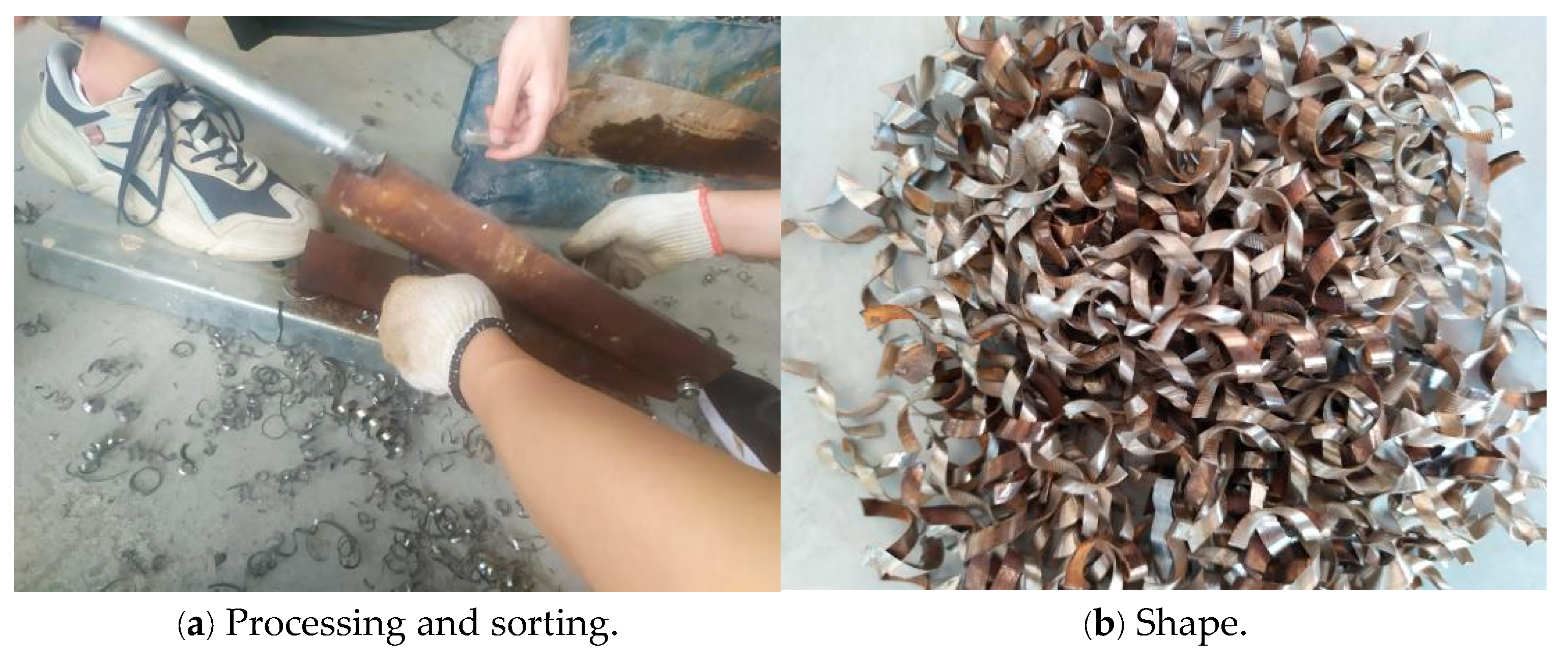
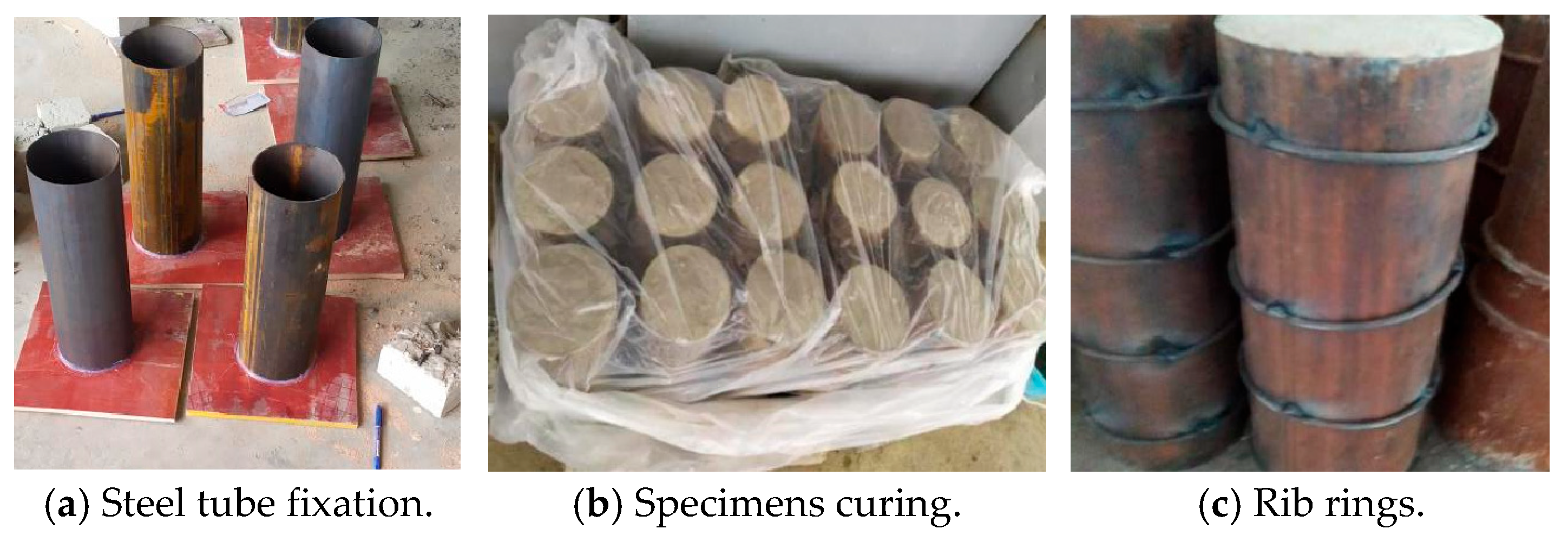
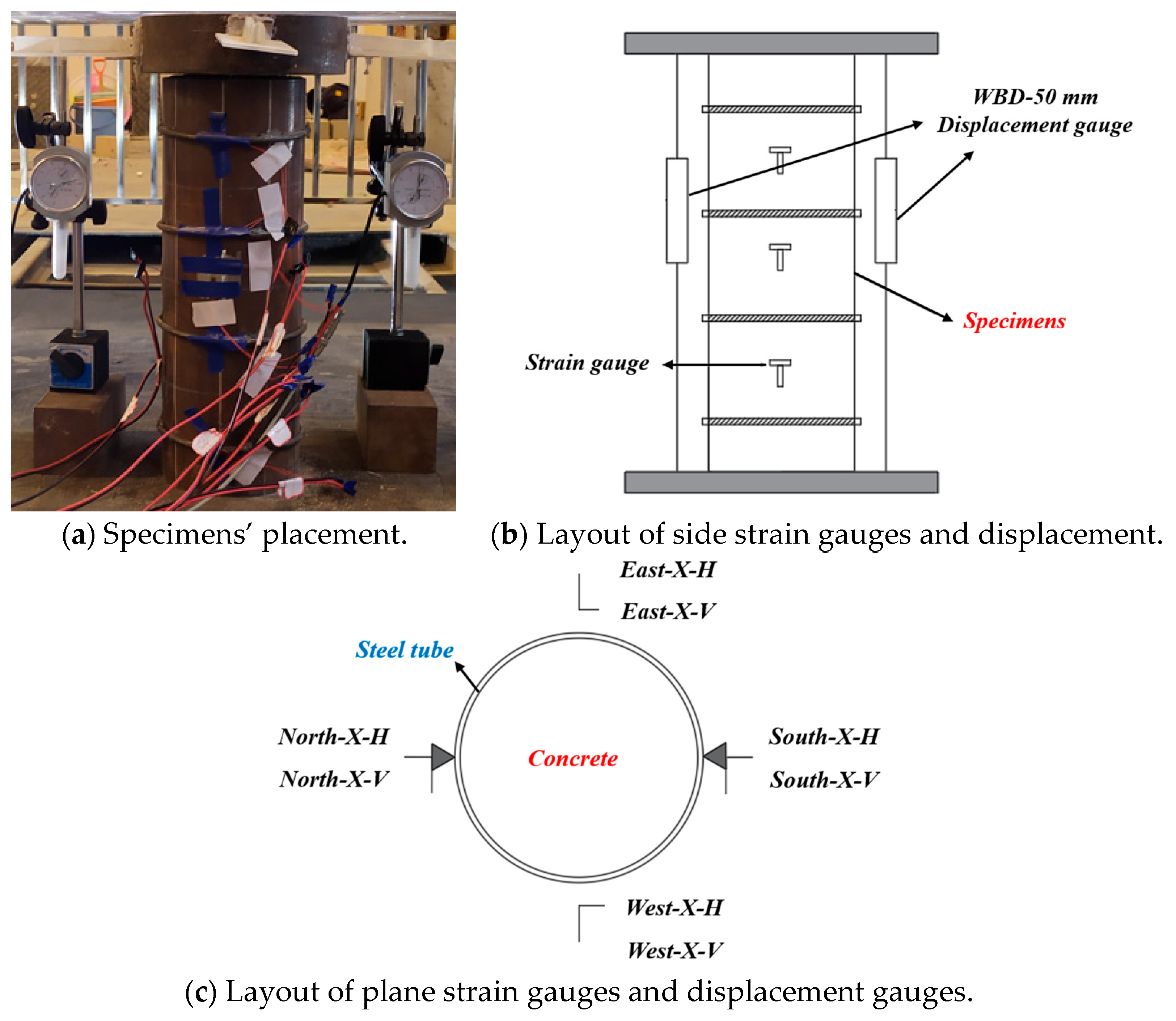
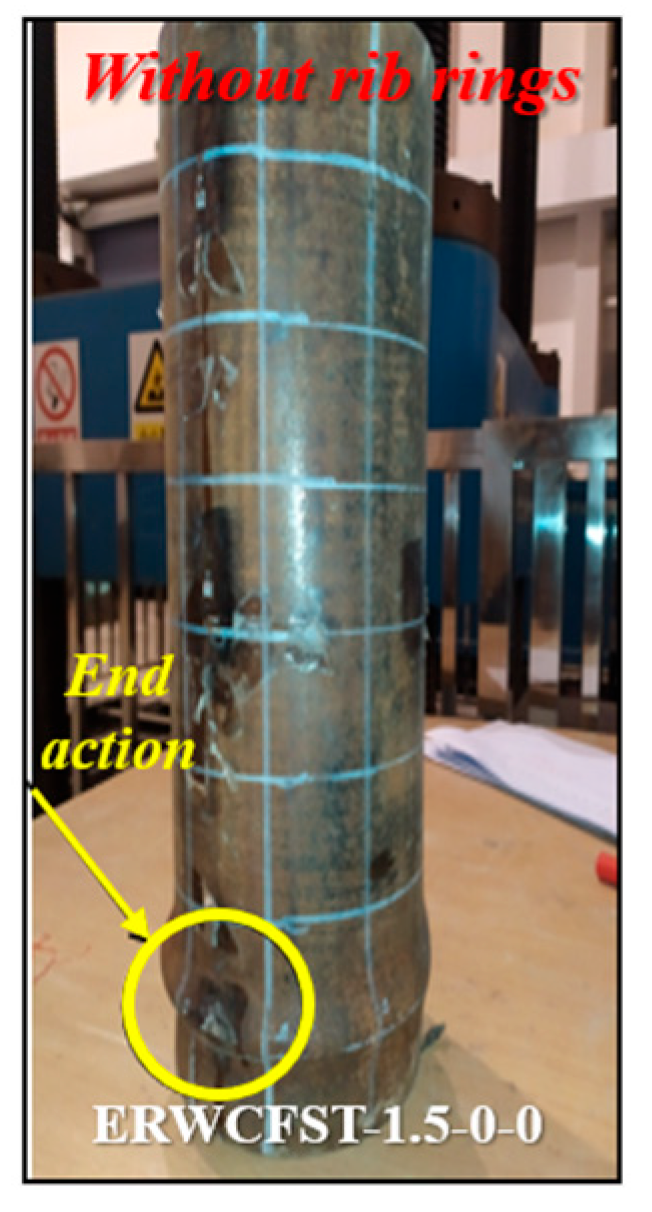
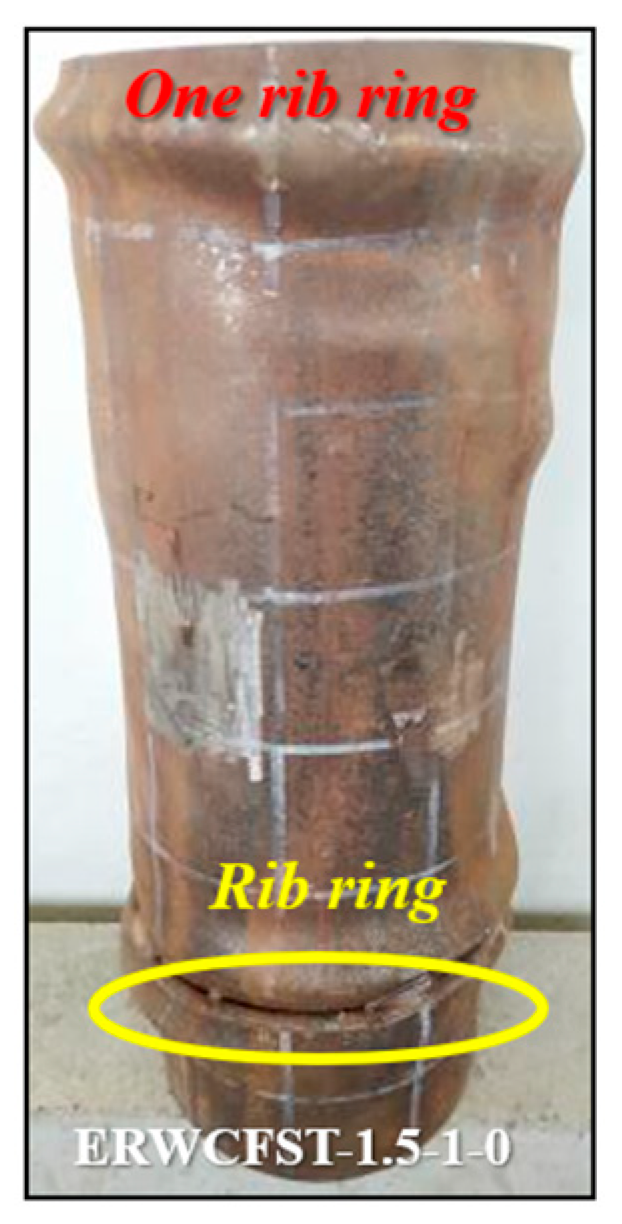
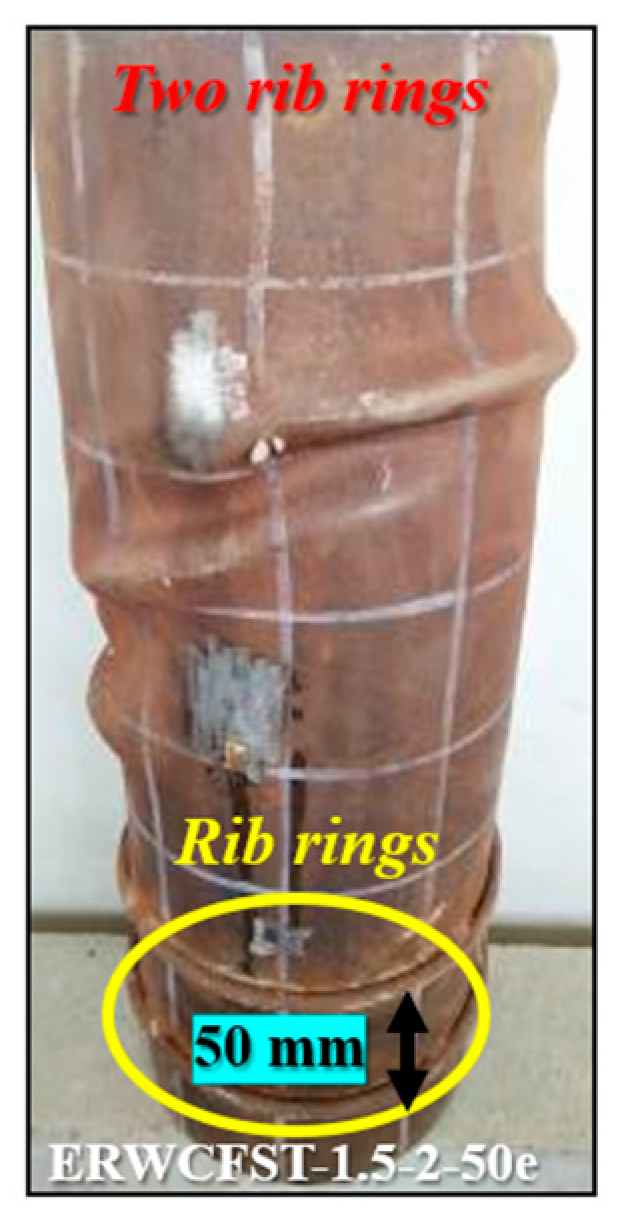

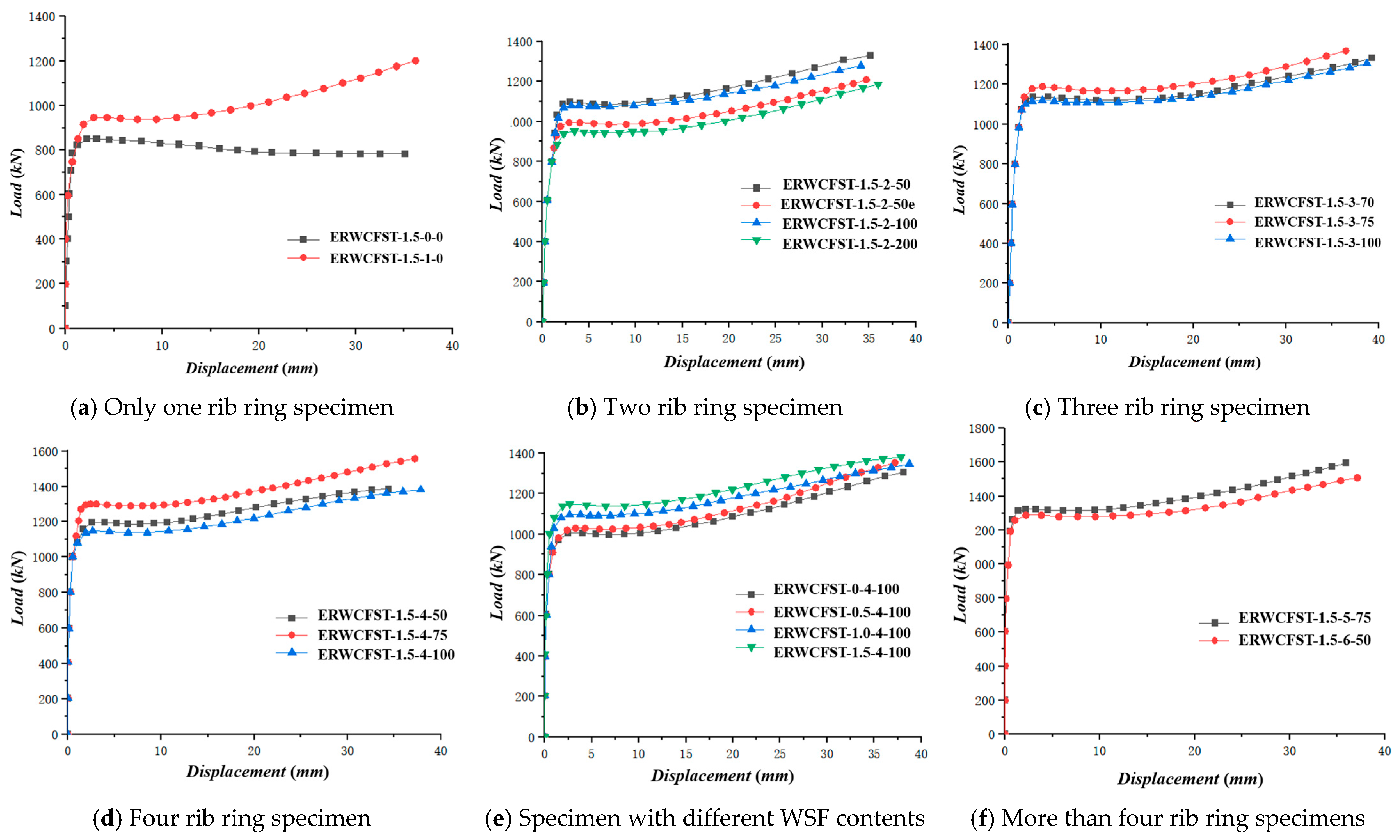
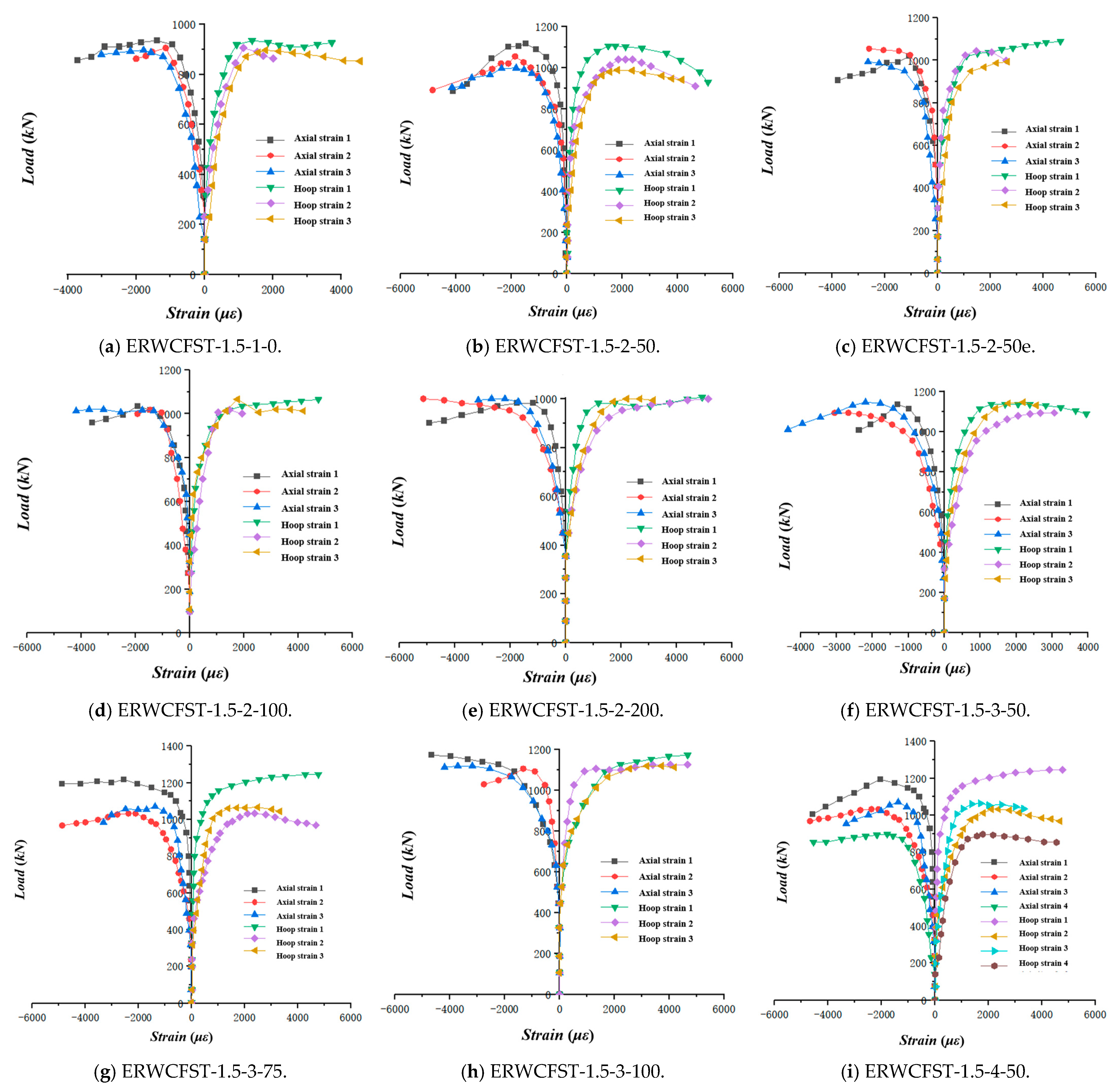
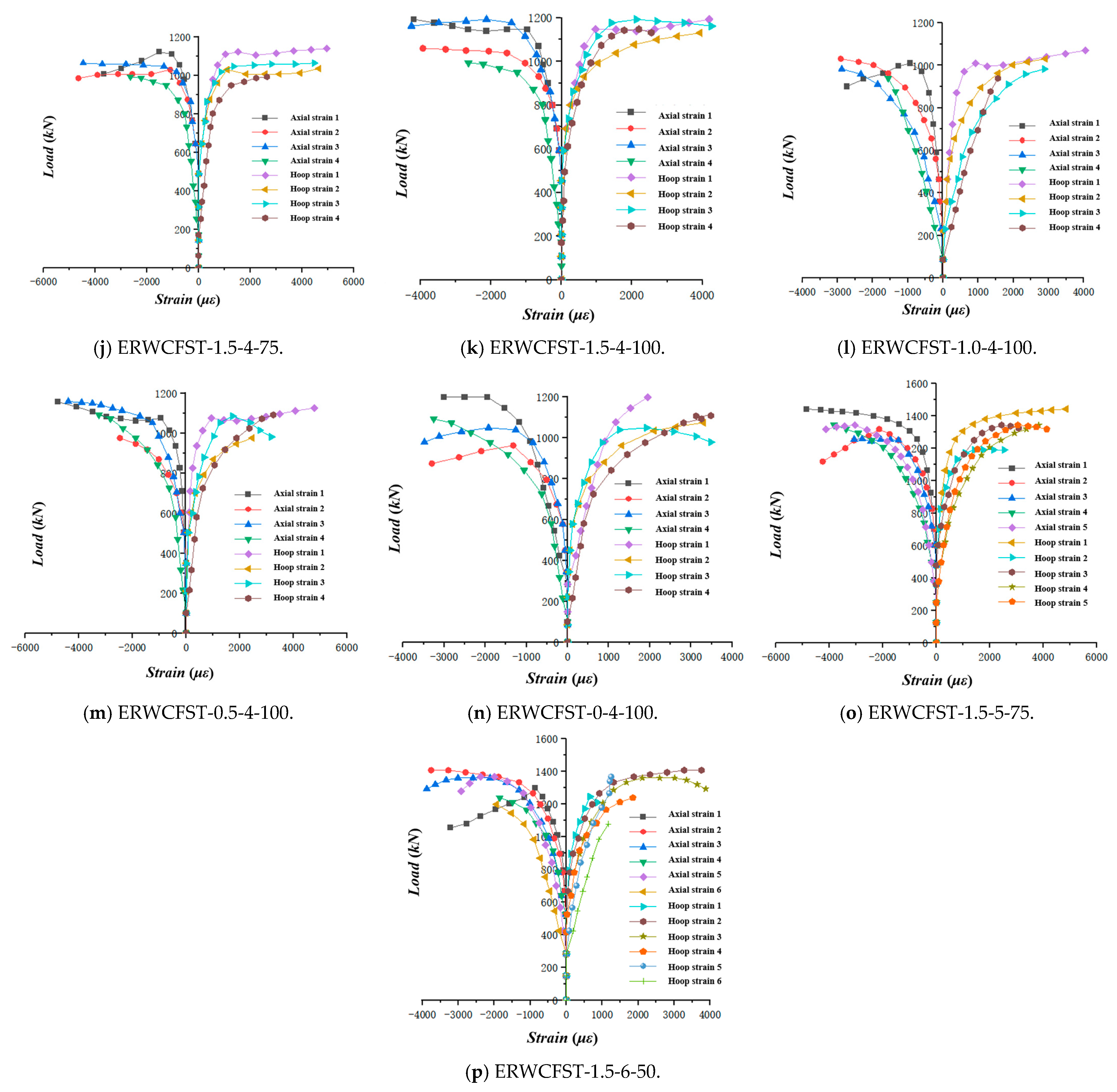
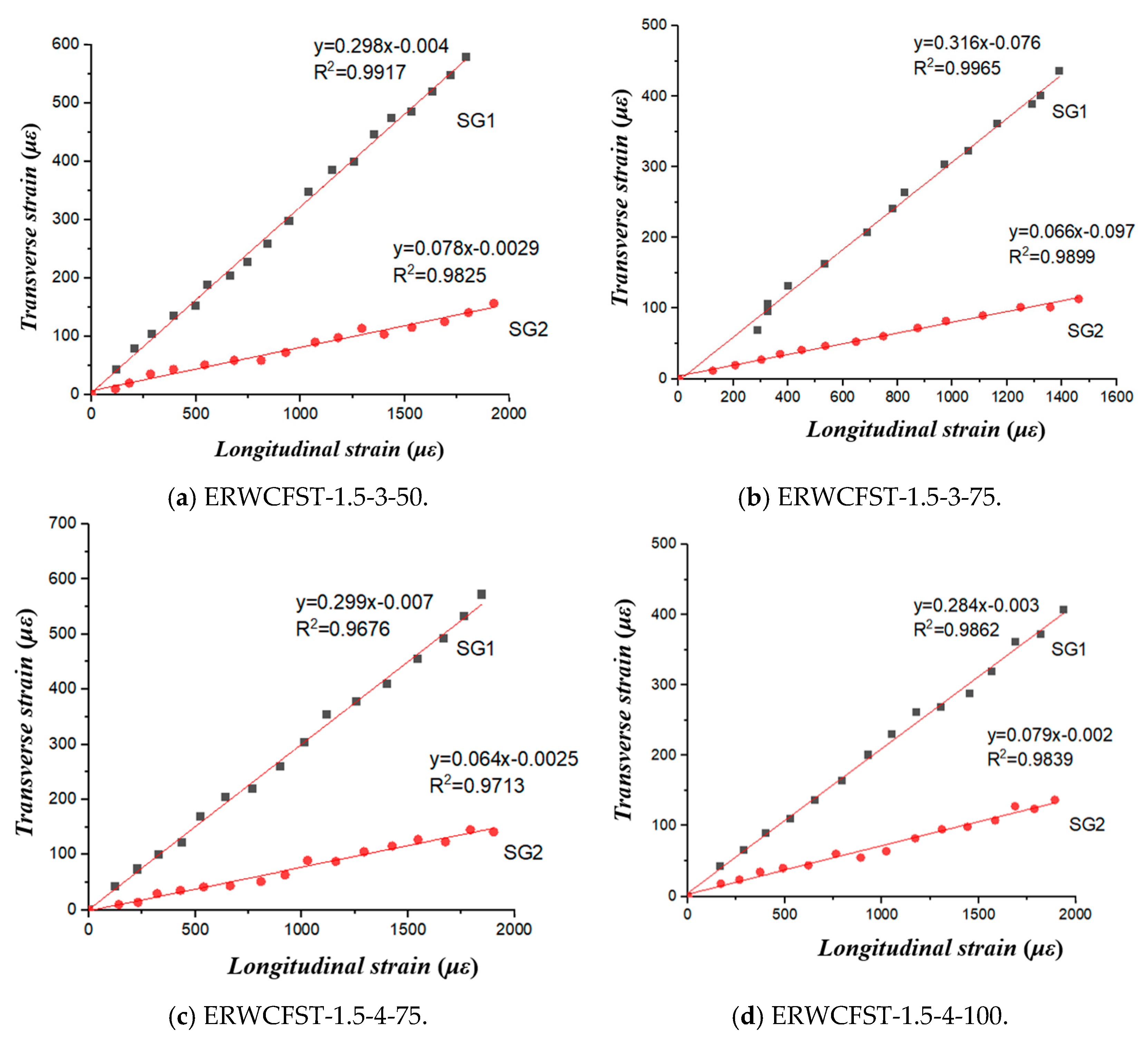
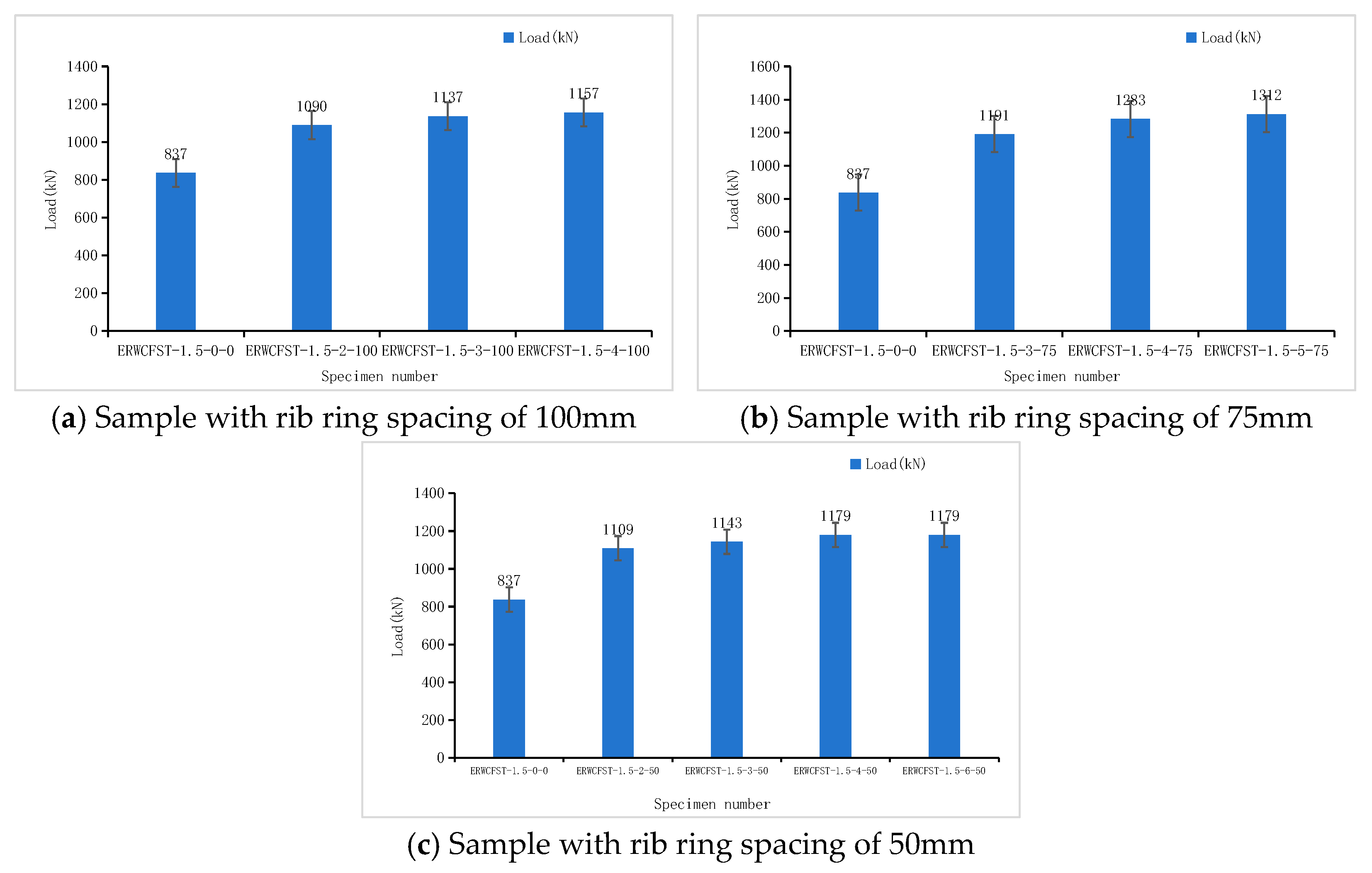
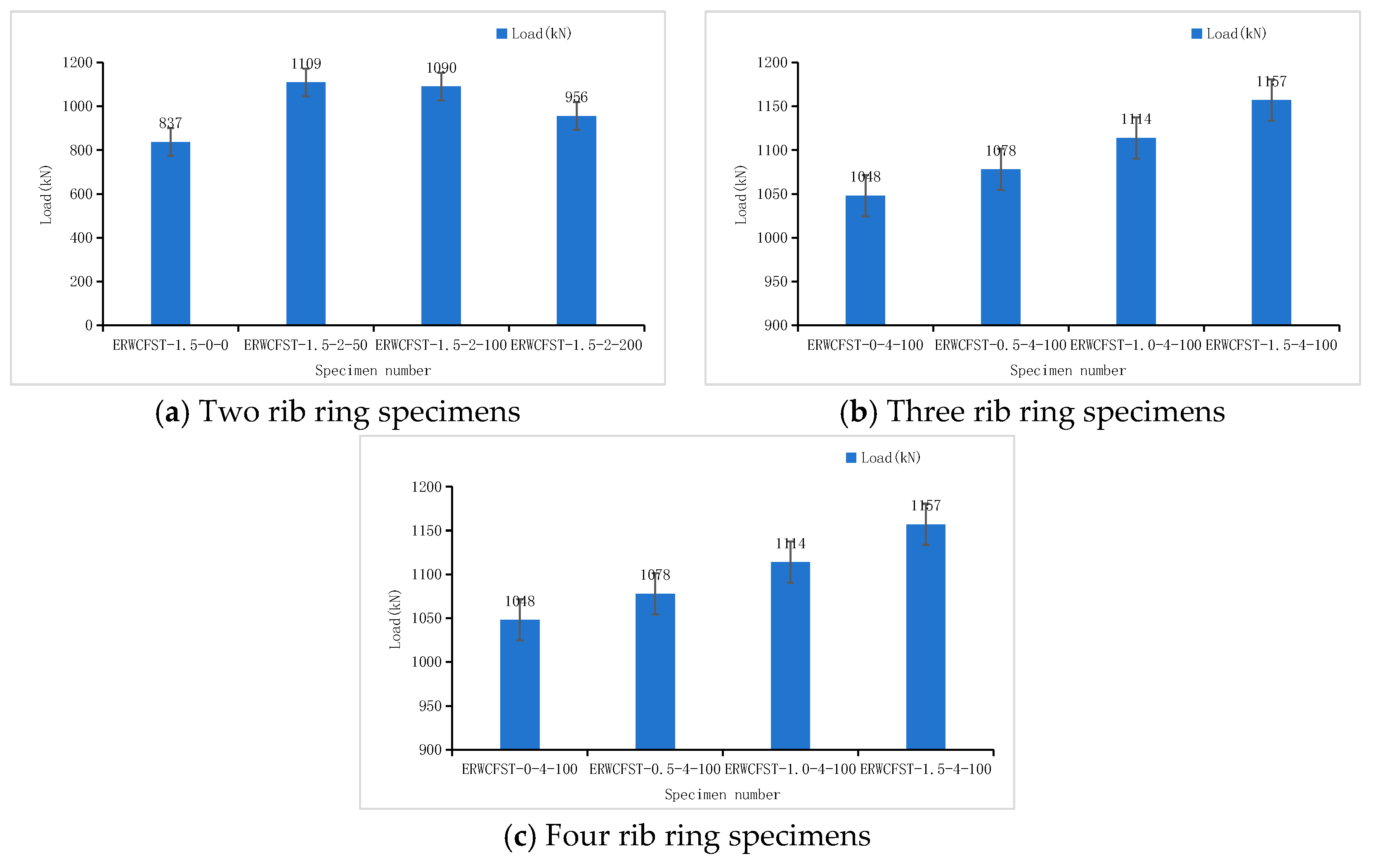
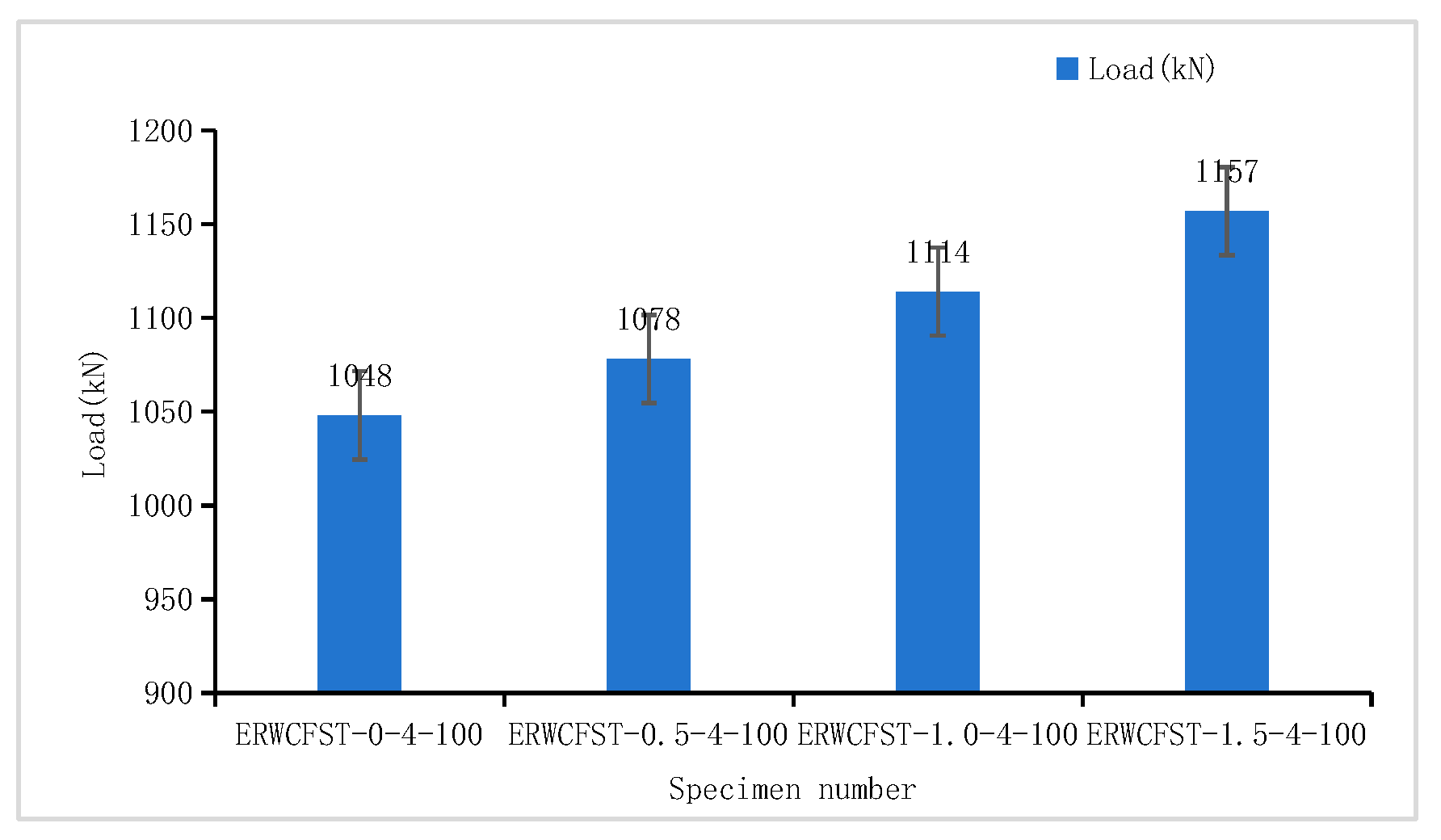
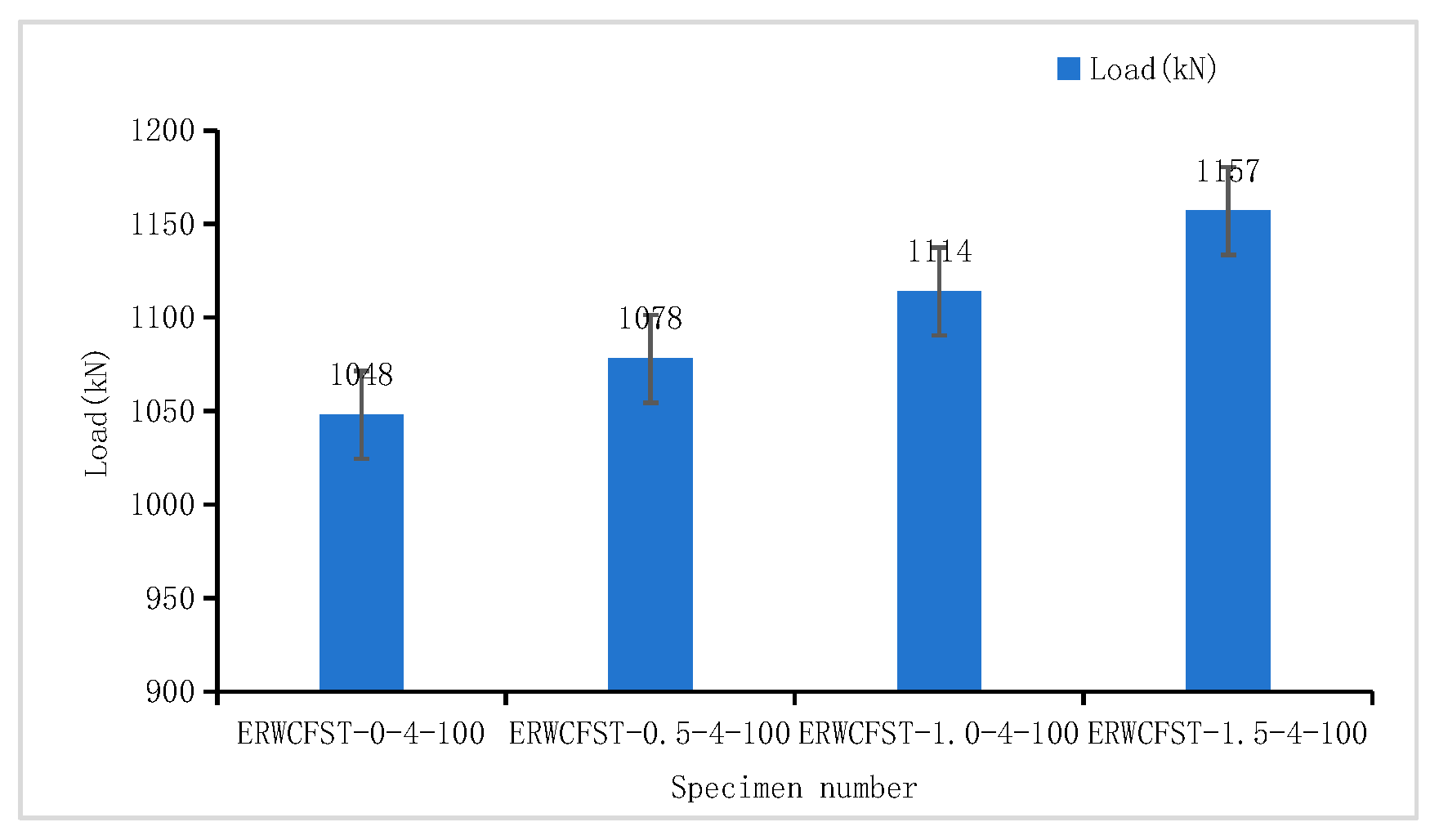
| Dimensions (D) /mm | Yield Strength (fy) /MPa | Ultimate Strength (fu) /MPa | Elastic Modulus (E) /×105 MPa | Poisson’s Ratio (v) |
|---|---|---|---|---|
| φ140 × 3 | 251 | 357 | 2.01 | 0.287 |
| φ6 | 300 | 455 | 2.01 | 0.283 |
| WSF Volume Content (%) | WSF Weight/kg/m3 | Cement/kg/m3 | Coarse Aggregate/kg/m3 | Sand/kg/m3 | Water/kg/m3 |
|---|---|---|---|---|---|
| 0 | 0 | 339.6 | 1241.1 | 639.3 | 180.0 |
| 0.5 | 39.5 | 339.6 | 1241.1 | 639.3 | 180.0 |
| 1.0 | 79 | 339.6 | 1241.1 | 639.3 | 180.0 |
| 1.5 | 118.5 | 339.6 | 1241.1 | 639.3 | 180.0 |
| Concrete Grades | Average Compressive Strength (fcu)/MPa | Axial Compressive Strength (fck)/MPa |
|---|---|---|
| C30 | 33.5 | 22.445 |
| C50 | 55.8 | 37.39 |
| Specimens Number | H × d × t | WSF Content/% | Rib Rings Number (N) | Rib Rings Spacing (S)/mm | Concrete Strength Grade |
|---|---|---|---|---|---|
| ERWCFST-1.5-0-0 | 400 × 140 × 3 | 1.5 | 0 | - | C30 |
| ERWCFST-1.5-1-0 | 400 × 140 × 3 | 1.5 | 1 | - | C30 |
| ERWCFST-1.5-2-50 | 400 × 140 × 3 | 1.5 | 2 | 50 | C30 |
| ERWCFST-1.5-2-50e | 400 × 140 × 3 | 1.5 | 2 | 50 | C30 |
| ERWCFST-1.5-2-100 | 400 × 140 × 3 | 1.5 | 2 | 100 | C30 |
| ERWCFST-1.5-2-200 | 400 × 140 × 3 | 1.5 | 2 | 200 | C30 |
| ERWCFST-1.5-3-50 | 400 × 140 × 3 | 1.5 | 3 | 50 | C30 |
| ERWCFST-1.5-3-75 | 400 × 140 × 3 | 1.5 | 3 | 75 | C30 |
| ERWCFST-1.5-3-100 | 400 × 140 × 3 | 1.5 | 3 | 100 | C30 |
| ERWCFST-1.5-4-50 | 400 × 140 × 3 | 1.5 | 4 | 50 | C30 |
| ERWCFST-1.5-4-75 | 400 × 140 × 3 | 1.5 | 4 | 75 | C30 |
| ERWCFST-1.5-4-100 | 400 × 140 × 3 | 1.5 | 4 | 100 | C30 |
| ERWCFST-1.0-4-100 | 400 × 140 × 3 | 1.0 | 4 | 100 | C30 |
| ERWCFST-0.5-4-100 | 400 × 140 × 3 | 0.5 | 4 | 100 | C30 |
| ERWCFST-0-4-100 | 400 × 140 × 3 | 0 | 4 | 100 | C30 |
| ERWCFST-1.5-5-75 | 400 × 140 × 3 | 1.5 | 5 | 75 | C30 |
| ERWCFST-1.5-6-50 | 400 × 140 × 3 | 1.5 | 6 | 50 | C30 |
| HERWCFST-1.5-0-0 | 400 × 140 × 3 | 1.5 | - | - | C50 |
| Specimens Number | Yield Load /kN | Yield Deformation/mm | Peak Load/kN | Strengthening Deformation/mm | Drum Deformation/mm | Stop Deformation/mm | Deformation Maximum /mm |
|---|---|---|---|---|---|---|---|
| ERWCFST-1.5-2-100 | 820 | 3.1 | 1090 | 5.8 | 14.1 | 25.8 | 35.8 |
| ERWCFST-1.5-2-200 | 775 | 2.9 | 956 | 6.8 | 21.5 | 23.2 | 27.2 |
| ERWCFST-1.5-3-50 | 889 | 2.8 | 1143 | 6.2 | 15.2 | 21.1 | 35.1 |
| ERWCFST-1.5-3-75 | 925 | 3.1 | 1181 | 6.6 | 15.3 | 25.8 | 36.2 |
| ERWCFST-1.5-3-100 | 995 | 3.6 | 1197 | 6.8 | 15.9 | 30.9 | 36.8 |
| ERWCFST-1.5-4-50 | 1046 | 2.8 | 1179 | 5.9 | 15.1 | 27.5 | 33.9 |
| ERWCFST-1.5-4-75 | 1045 | 4.8 | 1283 | 6.2 | 13.2 | 24.8 | 36.8 |
| ERWCFST-0-4-100 | 933 | 3.9 | 1048 | 5.3 | 15.9 | 27.9 | 34.2 |
| ERWCFST-0.5-4-100 | 967 | 3.8 | 1078 | 5.7 | 14.1 | 26.1 | 35.6 |
| ERWCFST-1.0-4-100 | 970 | 3.9 | 1114 | 6.2 | 15.8 | 27.8 | 35.2 |
| ERWCFST-1.5-4-100 | 1003 | 3.8 | 1157 | 5.7 | 15.2 | 33.7 | 40.3 |
| ERWCFST-1.5-5-75 | 1008 | 4.1 | 1312 | 5.1 | 17.9 | 30.1 | 38.2 |
| ERWCFST-1.5-6-50 | 1120 | 4.6 | 1282 | 5.3 | 22.9 | 35.8 | 39.3 |
| Specimen Number | Constraint Index/θ | SG1 | SG2 |
|---|---|---|---|
| ERWCFST-1.5-1-0 | 1.49 | 0.337 | 0.118 |
| ERWCFST-1.5-2-50 | 1.82 | 0.353 | 0.127 |
| ERWCFST-1.5-2-50e | 1.66 | 0.317 | 0.113 |
| ERWCFST-1.5-2-100 | 1.79 | 0.329 | 0.108 |
| ERWCFST-1.5-2-200 | 1.57 | 0.391 | 0.086 |
| ERWCFST-1.5-3-50 | 1.87 | 0.298 | 0.078 |
| ERWCFST-1.5-3-75 | 1.95 | 0.316 | 0.066 |
| ERWCFST-1.5-3-100 | 1.86 | 0.304 | 0.081 |
| ERWCFST-1.5-4-50 | 1.93 | 0.337 | 0.109 |
| ERWCFST-1.5-4-75 | 2.10 | 0.299 | 0.064 |
| ERWCFST-1.5-4-100 | 1.72 | 0.284 | 0.079 |
| ERWCFST-1.0-4-100 | 1.76 | 0.281 | 0.077 |
| ERWCFST-0.5-4-100 | 1.82 | 0.282 | 0.091 |
| ERWCFST-0-4-100 | 1.9 | 0.279 | 0.103 |
| ERWCFST-1.5-5-75 | 2.15 | 0.280 | 0.073 |
| ERWCFST-1.5-6-50 | 2.1 | 0.268 | 0.078 |
| ERWCFST-1.5-0-0 | 0.97 | 0.325 | - |
| HERWCFST-1.5-/-/ | 0.94 | 0.318 | - |
| Specimen Number | Spacing | N1 | ε1 | N2 | ε2 | μ |
|---|---|---|---|---|---|---|
| ERWCFST-1.5-0-0 | - | 837 | 0.00158 | 908 | 0.02680 | −2.81% |
| ERWCFST-1.5-1-0 | - | 912 | 0.00162 | 1036 | 0.02693 | −4.88% |
| ERWCFST-1.5-2-50 | 50 | 1109 | 0.00164 | 1292 | 0.02733 | −7.11% |
| ERWCFST-1.5-2-50D | 50 | 1021 | 0.00162 | 1177 | 0.02706 | −6.15% |
| ERWCFST-1.5-2-100 | 100 | 1090 | 0.00162 | 1227 | 0.02705 | −5.39% |
| ERWCFST-1.5-2-200 | 200 | 956 | 0.00167 | 1117 | 0.02782 | −6.16% |
| ERWCFST-1.5-3-50 | 50 | 1143 | 0.00156 | 1436 | 0.02687 | −11.57% |
| ERWCFST-1.5-3-75 | 75 | 1191 | 0.00158 | 1548 | 0.02722 | −13.93% |
| ERWCFST-1.5-3-100 | 100 | 1137 | 0.00158 | 1528 | 0.02726 | −15.23% |
| ERWCFST-1.5-4-50 | 50 | 1179 | 0.00163 | 1533 | 0.02673 | −14.09% |
| ERWCFST-1.5-4-75 | 75 | 1283 | 0.00173 | 1668 | 0.02833 | −14.47% |
| ERWCFST-1.5-4-100 | 100 | 1157 | 0.00161 | 1504 | 0.02644 | −13.98% |
| ERWCFST-1.0-4-100 | 100 | 1114 | 0.00167 | 1448 | 0.02738 | −13.00% |
| ERWCFST-0.5-4-100 | 100 | 1078 | 0.00171 | 1401 | 0.02811 | −12.25% |
| ERWCFST-0-4-100 | 100 | 1048 | 0.00162 | 1362 | 0.02655 | −12.61% |
| ERWCFST-1.5-5-75 | 75 | 1312 | 0.00166 | 1706 | 0.02717 | −15.43% |
| ERWCFST-1.5-6-50 | 50 | 1282 | 0.00185 | 1667 | 0.03037 | −13.49% |
| Specimen Number | Nexp | Nu3 | Nexp/Nu3 |
|---|---|---|---|
| ERWCFST-1.5-1-0 | 912 | 931 | 0.98 |
| ERWCFST-1.5-2-50 | 1109 | 1087 | 1.02 |
| ERWCFST-1.5-2-50D | 1021 | 1011 | 1.01 |
| ERWCFST-1.5-2-100 | 1090 | 1090 | 1.00 |
| ERWCFST-1.5-2-200 | 956 | 937 | 1.02 |
| ERWCFST-1.5-3-50 | 1143 | 1178 | 0.97 |
| ERWCFST-1.5-3-75 | 1191 | 1254 | 0.95 |
| ERWCFST-1.5-3-100 | 1137 | 1160 | 0.98 |
| ERWCFST-1.5-4-50 | 1179 | 1191 | 0.99 |
| ERWCFST-1.5-4-75 | 1283 | 1351 | 0.95 |
| ERWCFST-1.5-4-100 | 1048 | 1080 | 0.97 |
| ERWCFST-1.0-4-100 | 1078 | 1067 | 1.01 |
| ERWCFST-0.5-4-100 | 1114 | 1160 | 0.96 |
| ERWCFST-0-4-100 | 1157 | 1169 | 0.99 |
| ERWCFST-1.5-5-75 | 1312 | 1381 | 0.95 |
| ERWCFST-1.5-6-50 | 1282 | 1221 | 1.05 |
| Average value | 0.988 | ||
| Standard deviation | 0.072 |
Disclaimer/Publisher’s Note: The statements, opinions and data contained in all publications are solely those of the individual author(s) and contributor(s) and not of MDPI and/or the editor(s). MDPI and/or the editor(s) disclaim responsibility for any injury to people or property resulting from any ideas, methods, instructions or products referred to in the content. |
© 2025 by the authors. Licensee MDPI, Basel, Switzerland. This article is an open access article distributed under the terms and conditions of the Creative Commons Attribution (CC BY) license (https://creativecommons.org/licenses/by/4.0/).
Share and Cite
Gao, J.; Ren, X.; Gao, Y.; Li, Y.; Li, M. Compressive Behavior of Waste-Steel-Fiber-Reinforced Concrete-Filled Steel Tubes with External Steel Rib Rings. Buildings 2025, 15, 2246. https://doi.org/10.3390/buildings15132246
Gao J, Ren X, Gao Y, Li Y, Li M. Compressive Behavior of Waste-Steel-Fiber-Reinforced Concrete-Filled Steel Tubes with External Steel Rib Rings. Buildings. 2025; 15(13):2246. https://doi.org/10.3390/buildings15132246
Chicago/Turabian StyleGao, Jianhua, Xiaopeng Ren, Yongtao Gao, Youzhi Li, and Mingshuai Li. 2025. "Compressive Behavior of Waste-Steel-Fiber-Reinforced Concrete-Filled Steel Tubes with External Steel Rib Rings" Buildings 15, no. 13: 2246. https://doi.org/10.3390/buildings15132246
APA StyleGao, J., Ren, X., Gao, Y., Li, Y., & Li, M. (2025). Compressive Behavior of Waste-Steel-Fiber-Reinforced Concrete-Filled Steel Tubes with External Steel Rib Rings. Buildings, 15(13), 2246. https://doi.org/10.3390/buildings15132246





